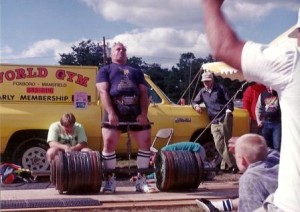The Hand and Thigh
By Eric Todd

Big Frank Ciavattone doing a big hand and thigh. Frank has not only promoted the Heavy Lift Championships in the past, he is a four time Heavy Lift Champion!
With the Heavy lift Championship just a few short months away, I am going to continue on with my series on the Heavy Lifts. The last article on the series focussed on the first lift we will be contesting at the event, the neck lift. This one will focus on the second lift in the order of the meet, the Hand and Thigh Lift. The hand and thigh lift is a quite old lift. It was a favorite of many old timers, and was done by many of them including Louis Cyr and Warren Lincoln Travis.
Quite a bit more should be lifted in the hand and thigh than in the neck lift. The heaviest neck lift is around 1000 pounds, while the heaviest hand and thigh is over 1900, by Joe Garcia. However, that is quite an outlier, as most of the rest of the best hand and thighers in the USAWA are in the 1500-1600s. The rules of the Hand and Thigh in the rulebook are as follows:
A Heavy Lift Bar is used in this lift. A hand bar is also used, which must not exceed 28 inches in length and 1 inch in diameter. The hand bar will have an adjustable chain and hook attached to it in the center so it may be attached to the Heavy Lift Bar. No knurling is allowed on the hand bar. The lifter assumes a position with the Heavy Lift Bar in front of the lifter, or the lifter may straddle it. The feet must be parallel and in line with the torso. Width of feet placement is optional. The feet must not move during the lift, but the heels and toes may rise. The lifter may adjust the chain length to his/her preference prior to the lift. The hand bar must be in the lifter’s grasp and will lie across the thighs. The hands must remain on the hand bar and must not change position during the lift. The lift begins at the lifter’s discretion. The lifter is allowed one test lift to check the balance of the weight and to make adjustments to the chain length. The lifter will stand or lean back to lift the weights from the platform. The shoulders and torso do not have to be upright upon the finish of the lift. The legs must straighten, but the knees do not need to be locked. Once the weight is motionless, and the plates on both ends of the bar are off the platform at the same time, an official will give a command to end the lift.
So, I have seen the hand and thigh done with both feet in front of the bar and also straddling the bar. That being said, from what I have seen, far better poundages are done with both feet in front of the bar. I like a flat sole, such as wrestling shoes for the hand and thigh (as well as all the heavy lifts for that matter) though I am not sure if that offers any advantages or not. Some people, me included, like to stand on a platform of sorts to complete the lift. It seems to give you better leverage to complete the lift. My platform comes by way of a few sawed off 4×4 timbers. Stance is optional, but I prefer a rather narrow one. I like my shins just a few inches behind the bar so my knees can float over the bar when I bend them to dig my knuckles into the top of my thighs. Grip is optional, but I would suggest double overhand with the thumbs in line with the fingers. You do not need your thumb to lock in the bar, as your thighs serve in that capacity, so I have been more successful with keeping them over the top of the bar. Once you have the bar locked into your thighs, lean way back, looking up, and drive back on your heels. The first few times I did this, I had someone spotting me from behind, because I felt I may fall over. I never have, though. As soon as both sides are off the platform simultaneously, you will get the down command. As you can see in the rules, if your chain length is wrong or you are off center and only one side comes up, you do have the opportunity to make one adjustment.
Not unlike the neck lift there is no absolute substitute for actually doing the hand and thigh to train for the hand and thigh. The technique takes some getting used to in order to become proficient at it to maximize your poundages. However, there are some movements that doing help strengthen your connective tissue. Strong connective tissue (such as tendons and ligaments) is crucial to heavy lifting. You could halfway simulate an hand and thigh with heavy partial barbell pulls in a rack. You could also play with heavy squat lockouts or heavy partials on the leg press to help build strength in your connective tissue.
Check out this video of Jim Malloy performing a 1200# Hand and Thigh at the 1991 National Championships, and keep training for the Heavy Lift Championship!